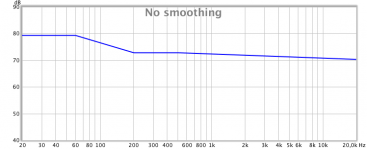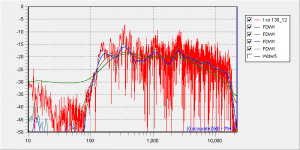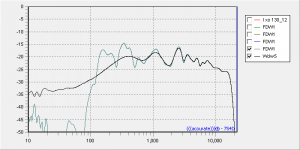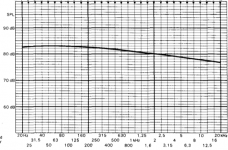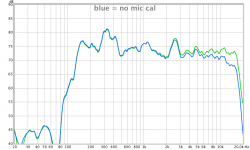Is that supposed to happen before or after averaging several locations? I'm curious how that would look if the input were many, many averages all around the listening area.
Uli uses only one single location. You might want to talk to him directly? Contact form - AudioVero
Mostly guessworkWhat is this number based upon?
For instance: Torsten Dau shows in Modeling auditory evoked brainstem responses to transient stimuli page 14-17 that tone bursts of 5-10 cycles excite nerve pulses from the equivalent parts of the basiliar membrane. That's just one part of my guesswork.
Not sure if this is useful Markus:
Acourate
1) Computer Audiophile - Acourate Digital Room and Loudspeaker Correction Software Walkthrough
2) Computer Audiophile - Advanced Acourate Digital XO Time Alignment Driver Linearization Walkthrough
I've been talking to Uli about this and Acourate indeed applies psychoacoustic filtering first followed by frequency dependent windowing.
Yes, this is the key. As Uli states on his site, "Acourate applies a psychoacoustic analysis to ensure correction filters fitting to the human ears" As mentioned before, I have tried numerous DRC products and Acourate is the only I have come across that is fit for human ears.
Others like Bob Katz, Mastering Engineer, also agree.
If one spends a bit of time on the Acourate forum, other insights can be gleaned. For example, a target response at the listening position, (see JJ Johnston's AES papers on psychoacoustics) that is flat to 1 kHz and using 1 kHz as a hinge point, draw a straight line to between -6 to -10 dB @ 20 kHz., depending on how live or dead your room is (and your preference!), produces a perceptually flat frequency response at the listening position. Most who have tried tend to agree. And not too much different than what was already known in the 1974 B&K paper (PDF).
As an ex recording/mixing engineer, the test for me is listening to one of my mixes from a well-designed (and very expensive to construct) acoustic environment and hearing the same tonal balance and stereo imaging that I know intimately being reproduced quite accurately on my home system means success in my books.
Acourate is more than room correction, as one can digital XO, time align, and linearize each driver, before applying room correction as described step by step in the articles that NorthStar linked above. This has significant impact on improving the SQ before room correction. One can even experiment with a virtual bass array if required.
I use CD horns from 500 Hz to 20 kHz. Whether standing or seated, or across a 3 person couch, the fr response sounds to my ears near identical. Same goes for the low end. There is a reason why one mic position allows correction of low frequencies over a large area of the room. Ask on the Acourate forum and you will have your answer.
Linear phase FIR filters sound best to me for the same reasons as Ackcheng states in the 3rd paragraph on his site Overall, I found his site to be a really good educational read and inspired me to toss my passive XO and go down a similar path. I am really glad I did.
Hope that helps and good luck.
mitchba,
Did you read the Harman paper "Listener Preferences for In-Room Loudspeaker and Headphone Target Responses" (AES Convention Paper 8994)? The preferred curve looks like this:

Quite a departure from the B&K curve.
Markus, yes I have seen that. Have you seen Sean's report on Audio Musings by Sean Olive: The Subjective and Objective Evaluation of Room Correction Products Have a look at Slide 24 in the presentation referenced in Sean's post. The noted preference is 0 dB at 20 Hz and straight line to -10 dB at 20 kHz, which is a bit different than what you have posted above.
I did use Sean's target (the one I linked to) for about a year with another DRC product, but it did not sound right to me. It had the sonic characteristic of sitting midway or towards the back of hall seating as opposed to being seated in row 5. Not that there is anything wrong with either
Also, relative to neutral, the bass sounded too forward, but I am looking for a neutral or transparent reproduction. Again, not to say that there is anything wrong with having a spectral balance that is more bass tilted. Personal preference perhaps, and/or different corrections based upon different psychoacoustic analysis algorithms.
However, I would say these 4 referenced targets are very similar, all with a -6 to -10 dB point at 20 kHz and flat to a certain hinge point, and that's where the point of departure is for each one. But they are all within +- 5 dB (or less) of each other. One can easily make corrections for each target and in real-time in JRiver's Convolution engine A/B the corrections. A personal preference can quickly be determined.
I have not changed my target in Acourate for almost a year. I am very happy with the spectral balance and have moved on to digital XO, time alignment, and driver linearization.
You're using minimum phase filters to "linearize" the drivers, though, right?
dumptruck, the answer is in the linearization procedure referenced in the article NorthStar linked to earlier.
Even so, it still doesn't look right
Some more graphs. Once more this is the long window response overlayed with all the frequency dependent windows from 1 to 8 cycles:
Here's a fixed 3ms window vs. frequency dependent window with 8 cycles:
Attachments
Last edited:
Attachments
This is essentially correction for Fletcher Munson curves at less than live listening levels.
Probably yes.
Sound is continuously changing air pressure, the ear responds to this. Ear doesn't care what is producing sound.
Correct but this doesn't help us much with the topic at hand. It's all about how that information is processed by our hearing.
Less pronounced (6dBs instead of 9).
Last edited:
Ace thread guys!
From the perspective of someone building speakers with only digital crossovers/eq there is a lot of useful information here.
One point I would make though:
A combination of holm impulse and rePhase can do pretty much everything you describe and they are free! FDW, most other types of gating/smoothing, linear or min phase PEQ, phase correction, crossovers slopes, time alignment etc.
Have you played with these programs?
I measure up close and apply FDW/smoothing in holm impulse, export the freq/phase to rePhase, apply linear phase PEQ to flat, correct phase, apply crossover. Then measure with these filters from listening position to generate a further tweaking filter (usually only a few db each way).
Have recently been playing with rolled off top, 'house curves' as you call them, but I find it extremely dependant on the particular recording whether a 5-10 db slope to 20khz sounds dull and muted, or just right.
From the perspective of someone building speakers with only digital crossovers/eq there is a lot of useful information here.
One point I would make though:
The best I have found is Acourate, which is not free, but under $400 and well worth it in my experience. With Acourate one can Digital XO, time align, and linearize each driver, plus room correction the fr and excess phase.
The linear phase FIR filters produced by Acourate are 64 bit (with 65536 taps) and JRiver's Convolution engine hosts them no problem with the benefit of taking into the account the latency produced by the filter so one can still watch movies with no lip sync issues.
One unique aspect of Acourate is it's measurement analysis uses a proprietary frequency dependent windowing (FDW) algorithm. Having used several acoustical analysis software packages over the years, to my ears, Acourate represents best what I see on the charts compared to what I perceive with my ears. The FDW is long at low frequencies (100’s of milliseconds) and short at high frequencies (< a millisecond).
A combination of holm impulse and rePhase can do pretty much everything you describe and they are free! FDW, most other types of gating/smoothing, linear or min phase PEQ, phase correction, crossovers slopes, time alignment etc.
Have you played with these programs?
I measure up close and apply FDW/smoothing in holm impulse, export the freq/phase to rePhase, apply linear phase PEQ to flat, correct phase, apply crossover. Then measure with these filters from listening position to generate a further tweaking filter (usually only a few db each way).
Have recently been playing with rolled off top, 'house curves' as you call them, but I find it extremely dependant on the particular recording whether a 5-10 db slope to 20khz sounds dull and muted, or just right.
You guys have a good point: We EQ our speakers to our room's acoustics, and one music recording from another requires new EQuing!
A program similar to Odyssee Motion Simulator (for D-Box - FOX studios), where each Blu-ray movie recording has its own sync bass EQ (amount and level of bass directed at your seat) with the on-screen action, would be cool.
But here with various type of music recordings where the auto sensor DSP EQ adjust itself from one recording to another with the required dose of EQ.
Or a time/frequency music analyzer like a Darbee enhancer, on a frame to frame basis.
It's done on video, and can be done on audio.
It would probably require complex computation, and would have to be stored in a DSP chip with high storage capapility. And it could be tailored to each own's preferred target curve and for each type of music and each individual music recording. Ouf!
Am I going ahead of myself here?
A program similar to Odyssee Motion Simulator (for D-Box - FOX studios), where each Blu-ray movie recording has its own sync bass EQ (amount and level of bass directed at your seat) with the on-screen action, would be cool.
But here with various type of music recordings where the auto sensor DSP EQ adjust itself from one recording to another with the required dose of EQ.
Or a time/frequency music analyzer like a Darbee enhancer, on a frame to frame basis.
It's done on video, and can be done on audio.
It would probably require complex computation, and would have to be stored in a DSP chip with high storage capapility. And it could be tailored to each own's preferred target curve and for each type of music and each individual music recording. Ouf!
Am I going ahead of myself here?
Last edited:
Why are we comparing "house curves" if they are different in every room with different speakers measuring really different in every room? I.m.h.o. there isn't one curve that satisfies all...
I agree that house curves are more a result of specific speaker/room interaction than a goal. We need to get a better understanding about the preceptual implications of that interaction.
Guys, aren't we trying to avoid house curves altogether ?
The fact that a "house curve" (that differs depding on room or speaker) needs to be applied shows that the wrong thing is being measured...any house curve at all is an admission that what we are measuring does not correlate with what we hear except in certain narrowly defined situations, eg specific room and speaker design combinations. Change the room or the speaker design (directivity profile in particular) and a given house curve becomes invalid.
The goal here should be to go beyond house curves and find the measurements that universally correlate with what we hear. Sliding window is a good start but is probably not the whole story, and the coefficients are yet to be fully worked out.
The fact that a "house curve" (that differs depding on room or speaker) needs to be applied shows that the wrong thing is being measured...any house curve at all is an admission that what we are measuring does not correlate with what we hear except in certain narrowly defined situations, eg specific room and speaker design combinations. Change the room or the speaker design (directivity profile in particular) and a given house curve becomes invalid.
The goal here should be to go beyond house curves and find the measurements that universally correlate with what we hear. Sliding window is a good start but is probably not the whole story, and the coefficients are yet to be fully worked out.
Last edited:
I agree that house curves are more a result of specific speaker/room interaction than a goal. We need to get a better understanding about the preceptual implications of that interaction.
The consequence of that interaction, in few words, will be a superposition of two events -the direct emission and the secondary emission- that will cause masking, loss of information. The direct emission already "has a room in it", artificial or natural doesn't matter, and it will change every time, or most of the times at least, you change CD or LP.
The best possible way to limit this is passive treatment of the room, a combination of absorption and diffusion, to get best out of the direct emission. But one needs quite a lot of material to do it and so it is not for everyone if the room is not just for listening. The directivity of your speakers already hepls at higher frequency. With a good passive treatment and, provided the room is big enough to place and listen to them properly, you would not need any subwoofer to get the real bass. No matter what frequency response of those Nathan's says. You would be amazed! I can bet on it.
The equalization does not change the room, is not a room a corrector, it does something to the signal! Time domain is more important to the listener than the frequency domain. They are not equivalent for him. You should know....
If the room cannot be treated I would go for another speaker that excites less the room: a small one. Higher SPL doesn't mean necessarily a more intense musical sensation. Quite different things in principle. Equalization is only good for someone looking for general standards but not for best individual perfomance.
- Status
- This old topic is closed. If you want to reopen this topic, contact a moderator using the "Report Post" button.
- Home
- General Interest
- Room Acoustics & Mods
- Room Correction with PEQ
